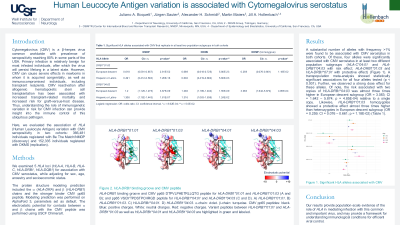Back

(P418) Human Leucocyte Antigen variation is associated with Cytomegalovirus serostatus
Location: Platinum Ballroom

Poster Presenter(s)
Aim: Cytomegalovirus (CMV) is a β-herpes virus common worldwide with prevalence of seropositivity reaching 80% in some parts of the USA. Primary infection is relatively benign for most infected individuals, after which the virus will persist lifelong in a latent state. However, CMV can cause severe effects in newborns in whom it is acquired congenitally, as well as immunocompromised individuals, including transplant recipients. CMV reactivation after allogeneic hematopoietic stem cell transplantation has been associated with increased transplant-related mortality and increased risk for graft-versus-host disease. Thus, understanding the role of immunogenetic variation in risk for CMV infection can provide insight into the immune control of this ubiquitous pathogen. Here, we evaluated the association of HLA (Human Leukocyte Antigen) variation with CMV seropositivity in two cohorts: 366,481 individuals registered with Be The Match/NMDP (discovery) and 152,335 individuals registered with DKMS (replication).
Method: We examined 5 HLA loci (HLA-A, HLA-B, HLA-C, HLA-DRB1, HLA-DQB1) for association with CMV serostatus, while adjusting for sex, age, ancestry and socioeconomic status.
Results: A substantial number of alleles with frequency >1% were found to be associated with CMV serostatus in both cohorts. Of these, four alleles were significantly associated with CMV serostatus in at least two different population subgroups (HLA-C*04:01 and HLA-DRB1*04:03 with risk effect; HLA-DRB1*01:03 and HLA-DRB1*07:01 with protective effect). A trans-population meta-analysis showed statistically significant associations for all four alleles tested (p < 0.001). Further, we observed a strong dose effect for these alleles. Of note, the risk associated with two copies of HLA-DRB1*04:03 was almost three times higher in European descent subgroup (OR = 3.083; CI = 1.642 – 5.874; p = 4.85E-04) relative to a single copy. Likewise, HLA-DRB1*01:03 homozygotes showed a protective effect almost three times higher than heterozygotes in European descent subgroup (OR = 0.259; CI = 0.076 – 0.661; p = 1.18E-02).
Conclusion: Our results provide population-scale evidence of the role of HLA in mediating infection with this common and important virus, and may provide a framework for understanding immunological conditions necessary for efficient viral control.
Method: We examined 5 HLA loci (HLA-A, HLA-B, HLA-C, HLA-DRB1, HLA-DQB1) for association with CMV serostatus, while adjusting for sex, age, ancestry and socioeconomic status.
Results: A substantial number of alleles with frequency >1% were found to be associated with CMV serostatus in both cohorts. Of these, four alleles were significantly associated with CMV serostatus in at least two different population subgroups (HLA-C*04:01 and HLA-DRB1*04:03 with risk effect; HLA-DRB1*01:03 and HLA-DRB1*07:01 with protective effect). A trans-population meta-analysis showed statistically significant associations for all four alleles tested (p < 0.001). Further, we observed a strong dose effect for these alleles. Of note, the risk associated with two copies of HLA-DRB1*04:03 was almost three times higher in European descent subgroup (OR = 3.083; CI = 1.642 – 5.874; p = 4.85E-04) relative to a single copy. Likewise, HLA-DRB1*01:03 homozygotes showed a protective effect almost three times higher than heterozygotes in European descent subgroup (OR = 0.259; CI = 0.076 – 0.661; p = 1.18E-02).
Conclusion: Our results provide population-scale evidence of the role of HLA in mediating infection with this common and important virus, and may provide a framework for understanding immunological conditions necessary for efficient viral control.

